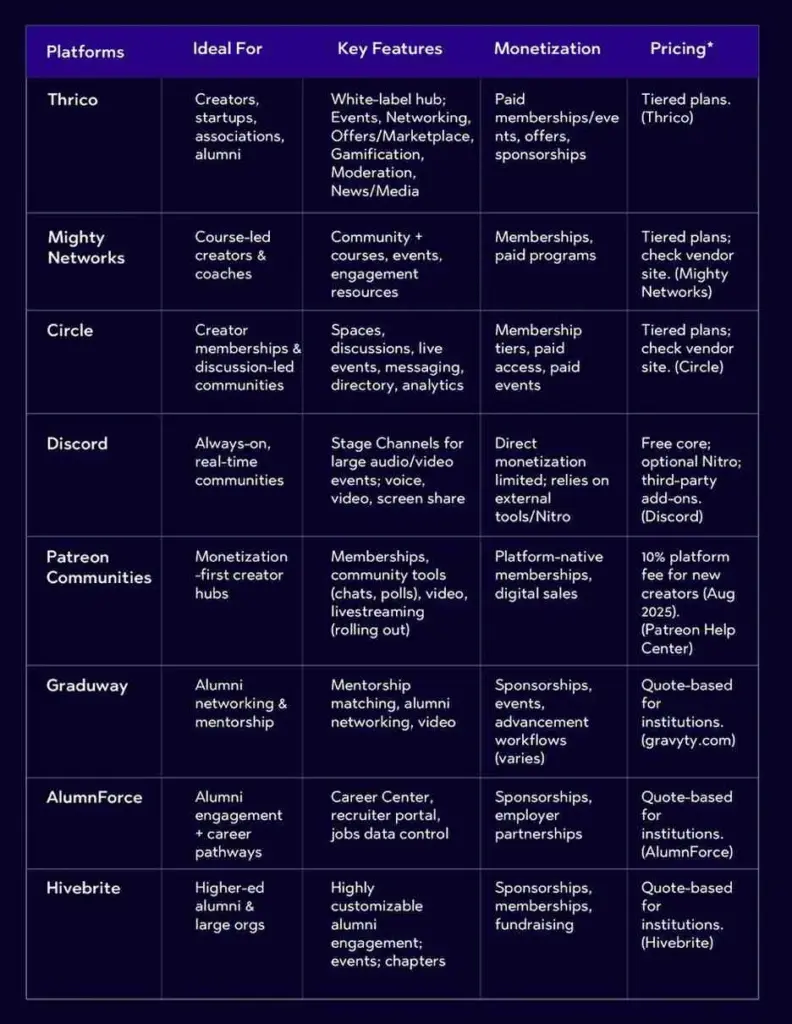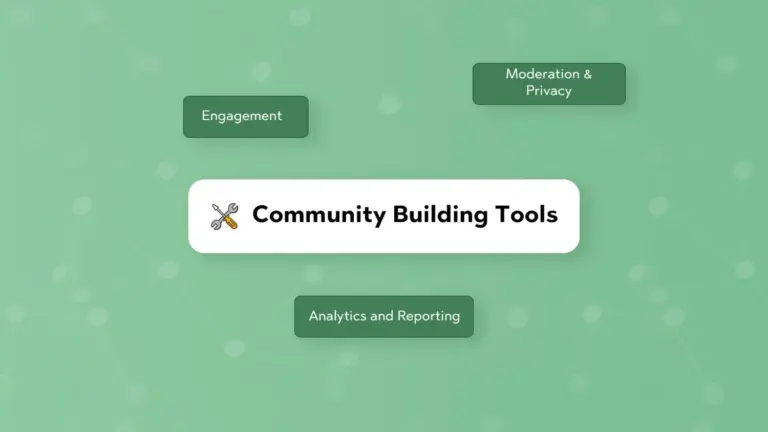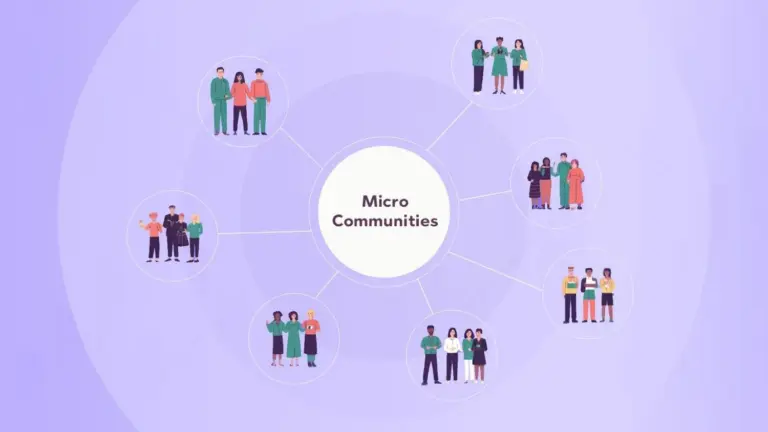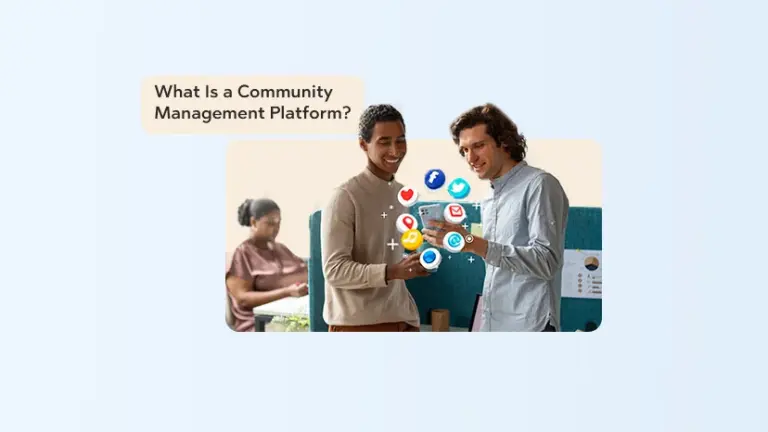Top Platforms for Creator and Alumni Communities
Online communities have matured from “nice-to-have” fan clubs and alumni groups into durable growth engines. In 2025, brands ship products with community feedback loops, creators launch careers by rallying superfans, and alumni offices turn networking into a measurable advantage for students and graduates. The common denominator: purpose-built community platforms that combine engagement, networking, and monetization into one stack.
Why do creators and alumni networks need dedicated platforms in the first place?
- Social networks are loud and rented. Algorithms change. Groups vanish. A community platform gives you control, data, and continuity.
- Members expect more than a chat thread. They want events, direct messaging, discovery tools, and a sense of belonging—without juggling six different apps.
- Revenues and outcomes depend on structure. Creators need memberships, paid events, and offers. Alumni teams need mentorship matching, directories, and chapter events.
Do it right, and you get four compounding benefits:
- Engagement: discussions, events, and projects that create participation—not just passive scrolling.
- Monetization: tickets, memberships, offers, and sponsorships that fund the mission.
- Networking: tools that help members meet the right people quickly (peers, mentors, partners, recruiters).
- Lifelong connections: a searchable history of people, stories, and impact that outlasts any social platform.
Thrico’s angle: Thrico was built to serve creators, associations, alumni programs, startups, and enterprises that want a white-label, community-first experience—complete with events, networking, offers/marketplace, gamification, moderation, and analytics—all under your brand. (Thrico)
What to Look for in Creator & Alumni Community Platforms
When evaluating the best community platforms of 2025, anchor on capabilities that directly move your goals:
a) Customization & Branding (white-label, design flexibility)
Your brand is not a skin; it’s the experience. Look for:
- White-label options (your domain, your colors, your voice).
- Modular layouts for home, spaces, events, and directories.
- Granular roles & permissions so staff, moderators, sponsors, faculty, or student leaders can manage their areas.
b) Engagement Tools (events, discussions, gamification, feedback)
Engagement requires multiple modalities:
- Discussions with threads, reactions, and rich media.
- Events (virtual, in-person, hybrid) with replays, Q&A, and polls.
- Gamification (points, badges, leaderboards) that rewards participation.
- Feedback loops (surveys, NPS, lightweight polls) to shape the roadmap.
Thrico, for example, emphasizes events + gamification to create momentum from day one. (Thrico)
c) Networking Features (DMs, groups, collaborations)
Communities stick when members meet the right people:
- Member directories with tags and filters.
- DMs and group chats for quick collaboration.
- Breakouts, speed networking, and topic rooms at events.
- Mentorship matching (critical for alumni platforms). (gravyty.com)
d) Monetization & Offers
Creators need sustainable revenue; associations and alumni teams often need to fund programming:
- Membership tiers and paid spaces.
- Ticketing and paid events (including hybrid).
- In-event offers/marketplace, sponsorship slots, and affiliates.
Patreon is a clear reference for membership-first monetization, with a standard 10% platform fee that grants access to its core tools like memberships and community features. (Patreon Help Center)
e) Moderation & Security (privacy, admin controls, safety)
- Access controls (members-only, cohorts, class years, chapters).
- Content moderation, profanity filters, report/flag tools.
- Privacy controls for profiles, directories, and event attendance.
- Compliance basics (data export, SSO/SAML in enterprise contexts).
f) Scalability & Ease of Use
As your community grows:
- Support chapters, cohorts, and multi-space architectures.
- Keep onboarding light with SSO/invites and intuitive navigation.
- Provide analytics that help you program smarter over time.
Top Platforms for Creator Communities
Below are leading options for creators—each with a different philosophy. Choose for fit, not just features.
1. Thrico — White-label control, events, gamification, marketplace
Best for: Creators, startups, associations, and teams that want a branded, all-in-one hub.
Standout: White-label experience where events, networking, offers (marketplace), feedback, and gamification are first-class. Thrico’s modules cover Communities, Events, Networking & Social Engagement, Buying & Offers, Entrepreneurship, Spotlight, Celebrations, Personal Growth & Learning, Giving, Feedback & Interaction, Gamification, News & Media, Help, and Moderation—a breadth that lets you launch with essentials and grow into more advanced use cases without switching stacks. (Thrico)
Why creators like it:
- Branded events with engagement features (Q&A, polls).
- Offers/marketplace for upsells and partner deals.
- Gamification to keep fans returning.
- Moderation & roles for team-run communities at scale. (Thrico)
2. Mighty Networks — Community + courses + events
Best for: Course-led creators and coaches who want to bundle teaching, community, and events.
Standout: Cohesive courses + memberships + events with an emphasis on community design principles and resources for creators. Their resources also cover virtual events extensively. (Mighty Networks)
3. Circle — Discussion-first, polished UI, live events
Best for: Creators who want a clean community space with threads, DMs, live events, and optional courses.
Standout: Spaces, live events, messaging, directory, customization, and analytics—a balanced toolset for membership communities. Third-party guides highlight events and native live streaming as well. (Circle)
4. Discord — Real-time voice/video/chat communities
Best for: Always-on communities, gaming/dev circles, and creator fandoms that love live rooms and Stage Channels.
Standout: Stage Channels make it simple to run structured audio/video events for large audiences—great for AMAs, drops, or community calls. (Discord)
5. Patreon Communities — Monetization-driven creator hubs
Best for: Creators prioritizing recurring memberships and direct fan support, with growing community tools (chats, comments, polls) and video.
Standout: Native memberships, digital product sales, video hosting, community features, and announced livestreaming—plus iOS changes enabling alternative payments that can increase creator take-home. Patreon’s 10% platform fee applies to new creators (effective Aug 2025). (Patreon Help Center)
Top Platforms for Alumni Communities
Alumni communities have special needs: accurate directories, mentorship, career services, chapters, and fundraising. These platforms lean into those use cases.
1. Thrico — Fast launch for associations & alumni
Best for: Universities, schools, colleges, and alumni associations seeking a white-label hub that combines events, networking, offers, mentorship-style engagement, and gamification under your brand.
Standout: Modules for Mentorship, Networking & Social Engagement, Events, Buying & Offers, Giving, News & Media, Moderation, and more—giving alumni teams a modern alternative to fragmented tools. (Thrico)
2. Graduway (by Gravyty) — Alumni networking & mentorship
Best for: Institutions prioritizing mentorship matching and career pathways.
Standout: Flash and formal mentoring, integrated video, and workflows designed for alumni relations teams. (gravyty.com)
3. AlumnForce — Engagement + career center
Best for: Alumni offices that want career services embedded in the community.
Standout: Career Center, recruiter portals, and control over jobs data and applications. (AlumnForce)
4. Hivebrite — Flexible community + events + fundraising
Best for: Higher-ed institutions and large organizations that need customizable alumni engagement with events and potential advancement/fundraising workflows.
Standout: A highly customizable platform trusted by global higher-ed; strong alumni-focused positioning. (Hivebrite)
5. Alumni Channel — Specialized alumni relationship management
Best for: Schools or associations wanting a purpose-built alumni hub with communication tools, events, directories, and role-based access. (If you’re evaluating, focus on directory accuracy, import tools, and user privacy.)
(Official feature pages vary; request a demo and verify the specifics for your institution.)
Comparison Table

| Platform | Ideal For | Key Features | Monetization | Pricing* |
| Thrico | Creators, startups, associations, alumni | White-label hub; Events, Networking, Offers/Marketplace, Gamification, Moderation, News/Media | Paid memberships/events, offers, sponsorships | Tiered plans.(Thrico) |
| Mighty Networks | Course-led creators & coaches | Community + courses, events, engagement resources | Membership tiers, paid access, paid events | Tiered plans; check vendor site. (Mighty Networks) |
| Circle | Creator memberships & discussion-led communities | Spaces, discussions, live events, messaging, directory, analytics | Membership tiers, paid access, paid events | Tiered plans; check vendor site. (Circle) |
| Discord | Always-on, real-time communities | Stage Channels for large audio/video events; voice, video, screen share | Direct monetization limited; relies on external tools/Nitro | Free core; optional Nitro; third-party add-ons. (Discord) |
| Patreon Communities | Monetization-first creator hubs | Memberships, community tools (chats, polls), video, livestreaming (rolling out) | Platform-native memberships, digital sales | 10% platform fee for new creators (Aug 2025). (Patreon Help Center) |
| Graduway | Alumni networking & mentorship | Mentorship matching, alumni networking, video | Sponsorships, events, advancement workflows (varies) | Quote-based for institutions. (gravyty.com) |
| AlumnForce | Alumni engagement + career pathways | Career Center, recruiter portal, jobs data control | Sponsorships, employer partnerships | Quote-based for institutions. (AlumnForce) |
| Hivebrite | Higher-ed alumni & large orgs | Highly customizable alumni engagement; events; chapters | Sponsorships, memberships, fundraising | Quote-based for institutions. (Hivebrite) |
*Pricing changes frequently; confirm with vendors during procurement.
Want a deeper look at modules beyond events—like directories, moderation, offers, and more? Explore Thrico’s Community building tools to see how everything fits together.
Benefits of Using the Right Platform
1. For creators → monetization, brand building, fan engagement
- Own your brand experience with a white-label hub instead of patching together chat, events, and payment tools.
- Launch faster programming: AMAs, workshops, cohort sessions, and office hours become templates you can reuse.
- Unlock multiple revenue lines: tiered memberships, paid events, and in-event offers turn attention into income (Thrico’s marketplace module is designed for these moments). (Thrico)
- Increase retention with gamification: lightweight points/badges and small challenges keep momentum between big launches. (Thrico)
2. For alumni → lifelong connection, networking, events, mentorship
- Centralize your alumni graph: accurate profiles, class years, industries, and interests power relevant introductions.
- Run chapter events (virtual or in-person) with automated reminders and replays; tie them to chapter goals.
- Formalize mentorship with matching tools and progress workflows (Graduway focus). (gravyty.com)
- Support career services: job boards, recruiter portals, and alumni referrals (AlumnForce focus). (AlumnForce)
- Coordinate advancement: spotlight stories and campaigns; track engagement to inform outreach (Hivebrite’s alumni positioning). (Hivebrite)
Challenges & How to Overcome Them
1. Adoption barriers
- Challenge: People resist “yet another platform.”
- Fix: Design a 90-day onboarding plan: welcome sequences, a “Start Here” space, and a weekly ritual (office hours or show-and-tell). Use calendar sync and reminders to reduce missed events.
- Thrico tip: Launch with one high-value event series and 2–3 evergreen spaces (Announcements, Intros, Wins). Layer features gradually.
2. Cost & procurement
- Challenge: Picking a platform means long-term commitment.
- Fix: Prototype a pilot community with 50–200 members. Validate KPIs: weekly active members (WAM), event attendance rate, post-event conversions. Use this data to justify budgets.
3. Training & moderation
- Challenge: Staff capacity and safety.
- Fix: Create a moderation playbook (role definitions, escalation paths, code of conduct). Hold a 30-minute “How to get value here” orientation for new members.
4. Community growth
- Challenge: Growth without chaos.
- Fix: Introduce chapters/cohorts once you cross a threshold (e.g., 500+ members). Promote member-led events and highlight a Member of the Week to distribute social capital.
5. Consistency
- Challenge: Peaks and valleys in engagement.
- Fix: Use a quarterly programming calendar with a drumbeat: monthly marquee event, bi-weekly workshops, weekly office hours, daily prompts. Tie participation to gamification rewards and spotlight features. (Thrico)
Measuring What Matters
Track KPIs that reflect health, not just vanity:
- Activation: % of new members who post or attend 1 event in 14 days.
- Participation: WAM/MAU and median comments per active member.
- Event performance: registered vs. attended, engagement (Q&A, polls), replay views.
- Network density: % of members with ≥3 DMs or 2 group memberships.
- Revenue: membership conversion, paid event revenue, offer/sponsor ROAS.
- Alumni outcomes: mentors matched, jobs filled, chapter activity, participation in giving.
FAQs
Start with fit: If you want white-label control with events, offers, and gamification, look at Thrico. If your model is courses-first, Mighty Networks is strong. For discussion-led memberships with clean UX, Circle shines. If your community lives in real-time chat/voice, Discord is the cultural match. If monetization is the core, Patreon Communities brings memberships and digital sales (and is expanding live video). (Thrico)
A verified directory, mentorship matching, chapter/event tooling, career services, and fundraising/advancement integrations—plus privacy and admin controls. Platforms like Graduway (mentorship), AlumnForce (career center), Hivebrite (customizable alumni hubs) are designed specifically for these. (gravyty.com)
Yes. Use tiered memberships, paid events, in-event offers/marketplace, sponsorships, and product drops. Patreon’s 2025 update clarifies a 10% platform fee for new creators and continues to invest in native video and livestreaming; other platforms support paid access in various ways. (Patreon Help Center)
Most alumni-focused vendors use quote-based pricing (depends on alumni size, modules, integrations). Creators tools commonly have tiered plans. Always confirm current pricing with vendors.
Yes—if it’s modular. Thrico’s approach is to ship community, events, networking, offers, gamification, moderation, mentorship and media as building blocks you can arrange for creators, associations, or alumni teams—under your brand. (Thrico)






